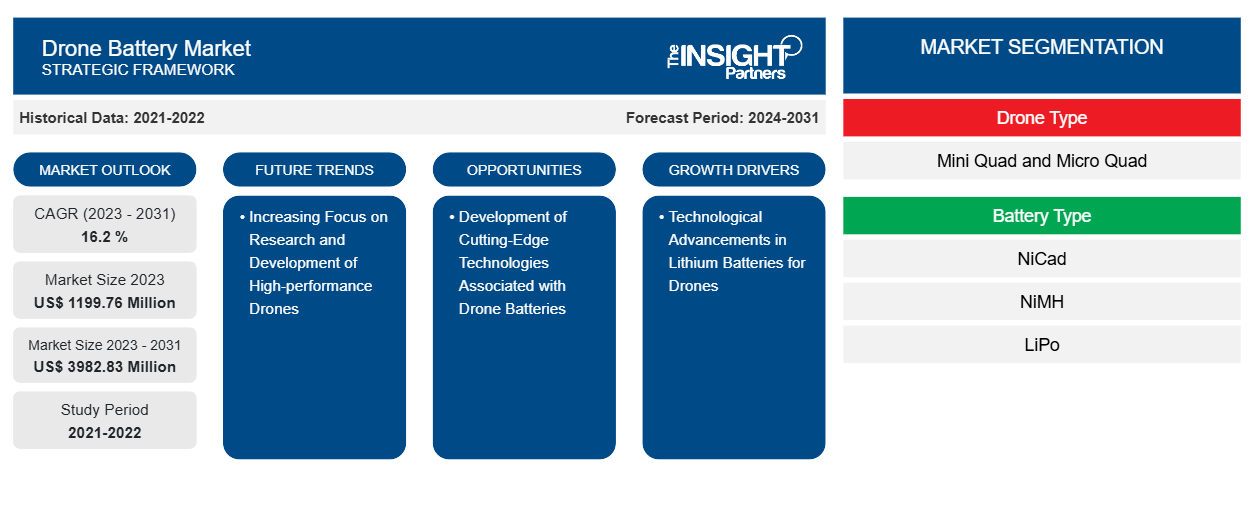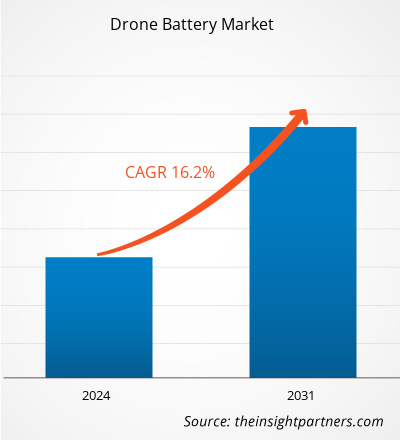The drone battery market size is projected to reach US$ 3982.83 million by 2031 from US$ 1199.76 million in 2023. The market is expected to register a CAGR of 16.2 % during 2023–2031. Increasing focus on research and development of high-performance drones is likely to remain a key trend in the market.
Drone Battery Market Analysis
The global drone battery market is mostly driven by the rising adoption of drones in a variety of applications such as surveying, mapping, and monitoring. Additionally, the increasing number of drone start-up businesses is driving the expansion of the drone battery market globally. For example, the total number of drone start-ups in India increased by 34% between August 2021 and February 2022. Such factors are providing opportunities for the drone battery market in India.
Drone Battery Market Overview
Drone batteries are rechargeable batteries that can be used for drones. They are generally made of Lithium-ion Polymer (Li-ion) or Lithium Polymer (LiPo) and come in various sizes and capacities. Drone batteries are necessary for longer flight times, and they pose a possible fire hazard if not properly handled. The type of batteries your drone uses can be an important factor in how the drone functions, including the time it takes to charge between uses and the rate of discharge. The most widely used drone batteries are Lithium Polymer (LiPo), Nickel Cadmium (NiCad), and Lithium-ion (Li-ion) batteries.
Customize This Report To Suit Your Requirement
You will get customization on any report - free of charge - including parts of this report, or country-level analysis, Excel Data pack, as well as avail great offers and discounts for start-ups & universities
Drone Battery Market: Strategic Insights

-
Get Top Key Market Trends of this report.This FREE sample will include data analysis, ranging from market trends to estimates and forecasts.
Drone Battery Market Drivers and Opportunities
Technological Advancements in Lithium Batteries for Drones
Drones have been experiencing notable growth globally over the past few years. Due to increased border security and enemy trespassing, several governments and companies focus on procuring UAVs. For instance, in 2022, the Federal Aviation Administration (FAA) reported that 855,860 drones were registered in the US in 2023. Therefore, with the increasing demand for drones, the battery market is expected to continue to grow significantly during the forecast period. Further, increasing country-specific drone associations such as the recently formed Czech Unmanned Aerial Alliance, l’Association du drone de l’industrie française (ADIF) in France, and numerous others in Asia, including Korea Drone Industry Association, the Korea Drone Association, Shenzhen UAV Industry Association, and the Japan UAS Industrial Development Association is also supplementing the growth of drone battery market.
Development of Cutting-Edge Technologies Associated with Drone Batteries
The market players are continuously developing batteries with lower internal resistance by raising their charging voltage. These batteries will support drones with higher density, higher cell capacity, lower mass, and maximum power density required for longer flight times. Manufacturers such as Amprius Technologies and KULR TECHNOLOGY GROUP, INC. are also developing next-generation batteries with an energy density of 400 Wh/kg and a charge/discharge cycle of at least 1,000 times. Thus, the development of cutting-edge technologies associated with drone batteries is anticipated to generate lucrative opportunities for market growth during the forecasted period.
Drone Battery Market Report Segmentation Analysis
Key segments that contributed to the derivation of the drone battery market analysis are drone type, battery type, battery capacity, and industry.
- Based on the drone type, the drone battery market is divided into mini quad and micro quad. The mini quad segment held a larger market share in 2023.
- By battery type, the market is segmented into NiCad, NiMH, and LiPo.
- By battery capacity, the market is segmented into below 3,000 mAh, 3,000-5,000 mAh, 5,000-10,000 mAh, and Above 10,000 mAh.
- By industry, the market is segmented into agriculture & forestry, infrastructure inspection, utilities, construction, mining, and others.
Drone Battery Market Share Analysis by Geography
The geographic scope of the drone battery market report is mainly divided into five regions: North America, Asia Pacific, Europe, Middle East & Africa, and South & Central America.
North America dominates the drone battery market. These investments and funding are expected to help drone providers expand their businesses and provide solutions to end users from various sectors. The growing demand for drones propels the need for batteries in North America, which is likely to benefit the drone battery market in the region.
Drone Battery Market Regional Insights
The regional trends and factors influencing the Drone Battery Market throughout the forecast period have been thoroughly explained by the analysts at The Insight Partners. This section also discusses Drone Battery Market segments and geography across North America, Europe, Asia Pacific, Middle East and Africa, and South and Central America.
Drone Battery Market Report Scope
| Report Attribute | Details |
|---|---|
| Market size in 2023 | US$ 1199.76 Million |
| Market Size by 2031 | US$ 3982.83 Million |
| Global CAGR (2023 - 2031) | 16.2 % |
| Historical Data | 2021-2022 |
| Forecast period | 2024-2031 |
| Segments Covered |
By Drone Type
|
| Regions and Countries Covered |
North America
|
| Market leaders and key company profiles |
|
Drone Battery Market Players Density: Understanding Its Impact on Business Dynamics
The Drone Battery Market is growing rapidly, driven by increasing end-user demand due to factors such as evolving consumer preferences, technological advancements, and greater awareness of the product's benefits. As demand rises, businesses are expanding their offerings, innovating to meet consumer needs, and capitalizing on emerging trends, which further fuels market growth.

- Get the Drone Battery Market top key players overview
Drone Battery Market News and Recent Developments
The drone battery market is evaluated by gathering qualitative and quantitative data post primary and secondary research, which includes important corporate publications, association data, and databases. A few of the developments in the drone battery market are listed below:
- RRC Power Solutions GmbH adopted a dual-sourcing strategy to prevent supply shortages. The strategy helps the company develop existing standard battery packs like the RRC2054 and plan product launches with shorter delivery times. (Source: RRC Power Solutions GmbH, Press Release, May 2022.)
- EaglePicher Technologies provided essential battery technology to power both the Orion spacecraft crew module and the Space Launch System (SLS) flight termination system used in NASA’s Artemis I Launch. EaglePicher Technologies provides 120-volt rechargeable lithium-ion batteries that power the crew module, which consists of communications, propulsion, navigation, and thermal control. (Source: EaglePicher Technologies, Press Release, August 2023)
Drone Battery Market Report Coverage and Deliverables
The “Drone Battery Market Size and Forecast (2021–2031)” report provides a detailed analysis of the market covering below areas:
- Drone battery market size and forecast at global, regional, and country levels for all the key market segments covered under the scope
- Drone battery market trends as well as market dynamics such as drivers, restraints, and key opportunities
- Detailed PEST/Porter’s Five Forces and SWOT analysis
- drone battery market analysis covering key market trends, global and regional framework, major players, regulations, and recent market developments
- Industry landscape and competition analysis covering market concentration, heat map analysis, prominent players, and recent developments in the drone battery market
- Detailed company profiles
Frequently Asked Questions
Which region dominated the drone battery market in 2023?
What are the driving factors impacting the drone battery market?
Which are the leading players operating in the drone battery market?
What are the future trends of the drone battery market?
What is the expected CAGR of the drone battery market?
What would be the estimated value of the drone battery market by 2031?
- Historical Analysis (2 Years), Base Year, Forecast (7 Years) with CAGR
- PEST and SWOT Analysis
- Market Size Value / Volume - Global, Regional, Country
- Industry and Competitive Landscape
- Excel Dataset
Recent Reports
Related Reports
Testimonials
Reason to Buy
- Informed Decision-Making
- Understanding Market Dynamics
- Competitive Analysis
- Identifying Emerging Markets
- Customer Insights
- Market Forecasts
- Risk Mitigation
- Boosting Operational Efficiency
- Strategic Planning
- Investment Justification
- Tracking Industry Innovations
- Aligning with Regulatory Trends





















 Get Free Sample For
Get Free Sample For